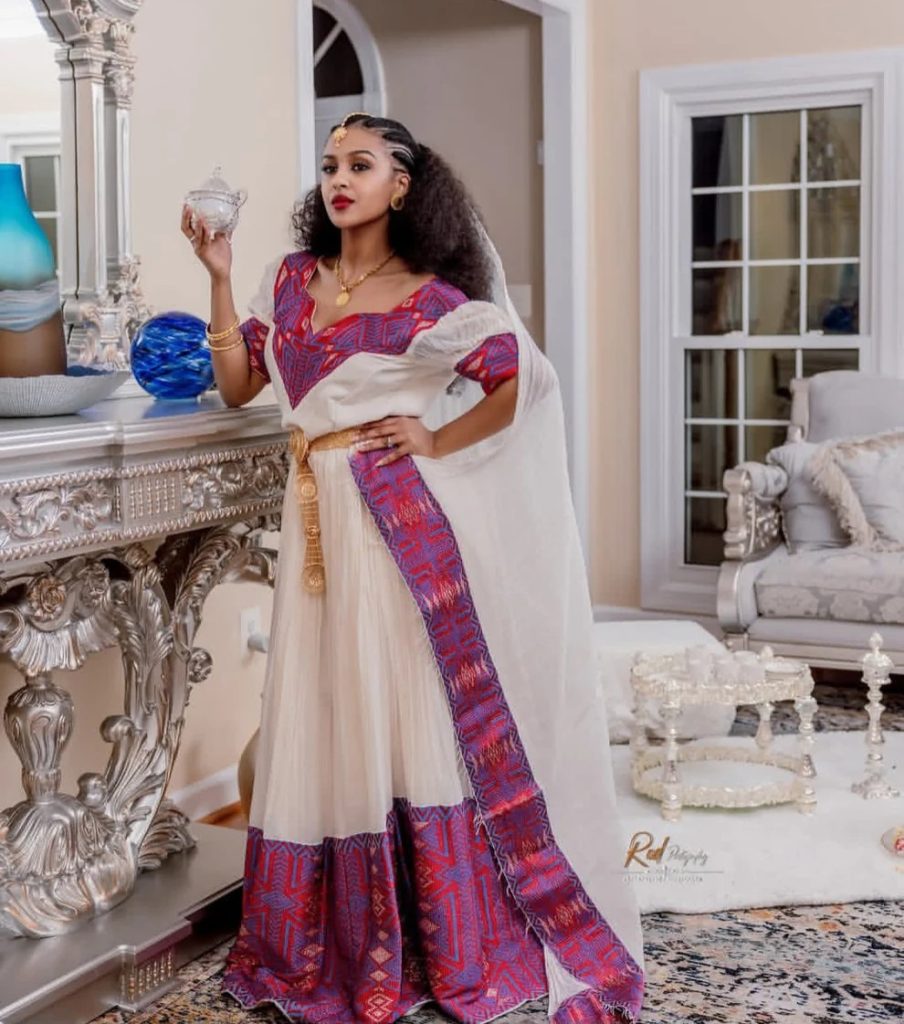Habesha Kemis: The Timeless Ethiopian Dress Every Woman Should Know
In Ethiopia and Eritrea, few garments carry as much meaning as the Habesha Kemis, often referred to simply as the Habesha dress. It is more than a fashion piece; it is a symbol of cultural pride, identity, and continuity across generations. The white, handwoven cotton with intricate embroidery is instantly recognisable, and yet the style has proven adaptable in a world where fashion trends constantly change.
For many women, owning an Ethiopian traditional dress is not only about looking elegant but also about connecting with heritage. Whether worn at weddings, religious holidays, or cultural celebrations, the Habesha Kemis holds its place as one of the most iconic garments in the Horn of Africa. In this article, we will explore the history, meaning, and modern interpretations of the Habesha dress, while also looking at how Ethiopian and Eritrean traditions overlap and differ.
What is the Habesha Kemis? (Defining the Ethiopian Traditional Dress)
The Habesha Kemis is the quintessential Ethiopian dress, traditionally made from handwoven cotton known as shemma (ሸማ). The base is usually white or off-white, symbolising purity and simplicity, but it is never plain. What makes the dress distinctive is the decorative embroidery, called tibeb, which runs along the edges, sleeves, and hem.

Classic Eritrean dress with traditional embroidery and a cotton fabric
Women typically wear the dress with a matching scarf, the netela, which drapes gracefully over the shoulders or head. These scarves often carry their own tibeb designs, complementing the patterns on the dress itself.
The style of Habesha Kemis varies depending on the region and the wearer’s preferences. Some are long and flowing with wide sleeves, while others are more fitted and modern. The beauty lies in its flexibility; it can be worn as both casual daywear or as an elaborate outfit for weddings and formal gatherings.
History and Cultural Significance of Ethiopian Traditional Dress
The roots of the Ethiopian traditional dress stretch back centuries, reflecting the weaving traditions and artistic skills of local communities. The process of creating shemma fabric was historically labour-intensive, done by hand on traditional looms. This is why, even today, authentic Habesha dresses carry a sense of value and craftsmanship.
The dress is strongly tied to cultural identity. For Ethiopian and Eritrean women, wearing the Habesha Kemis is a way of honouring ancestry and maintaining a visible link to cultural heritage. It is not simply about fashion but about embodying values such as modesty, pride, and unity.
During major religious festivals such as Meskel, Timket, or Easter, streets in Addis Ababa or Asmara are filled with women dressed in white Habesha Kemis. At weddings, brides may wear elaborately embroidered versions, often incorporating gold threads, while guests also arrive in their own traditional attire. This shared practice reinforces a collective identity.
Interestingly, the white background of the dress carries symbolic weight. In both Ethiopian Orthodox and Eritrean traditions, white clothing represents spirituality, peace, and community purity. The embroidery colours, green, red, yellow, blue, are not random either. They often reflect the Ethiopian flag or carry meanings tied to fertility, prosperity, or joy.
Habesha Dress vs Eritrean Dress – Similarities and Subtle Differences
Because Ethiopia and Eritrea share deep cultural and historical ties, the Habesha dress and the Eritrean dress are closely related. Both are rooted in the same weaving techniques, use the same shemma fabric, and are adorned with tibeb (ጥበብ) embroidery.
However, there are subtle differences that make each unique. Eritrean versions of the dress often feature brighter colours and more geometric embroidery patterns, while Ethiopian designs sometimes lean toward floral motifs and softer tones. In Eritrea, the matching headscarf is commonly styled differently, sometimes covering the hair completely, especially during religious events.
These differences are not divisions but reflections of how a shared tradition adapts regionally. For women in both Ethiopia and Eritrea, the dress continues to serve as an expression of pride and a reminder of common cultural roots.
Modern Interpretations of the Habesha Kemis
While the Ethiopian traditional dress is deeply tied to heritage, modern fashion has redefined how it is worn. Contemporary designers have introduced fitted silhouettes, bold embroidery in metallic tones, and even shorter variations that appeal to younger audiences.
Diaspora communities, particularly in the US and Europe, have embraced these modern versions. For example, Ethiopian weddings abroad often showcase bridesmaids dressed in coordinated Habesha Kemis styles designed to match Western bridal fashion. This blending of old and new shows the adaptability of the dress.
On international fashion stages, African designers have also highlighted the Habesha Kemis as part of a broader movement to bring traditional African attire into global conversations. In recent years, we’ve seen Ethiopian celebrities and influencers wearing Habesha dresses at major cultural events, introducing the style to audiences beyond the Horn of Africa.

Traditional Ethiopian dress with intricate gold border details
Styling the Habesha Kemis for Every Occasion
One of the reasons the Habesha Kemis remains relevant is its versatility. It can be styled differently depending on the occasion:
Weddings
At Ethiopian weddings, the bride’s Habesha wedding dress is often more elaborate, with gold and coloured embroidery across the bodice, sleeves, and hemline. Brides may also pair the dress with a gold tiara or crown, blending tradition with grandeur. Guests, meanwhile, wear simpler but still elegant versions.
Religious Ceremonies
For church services, women often choose plain white or lightly embroidered Habesha Kemis paired with a head-covering netela, reflecting modesty and reverence.
Cultural Celebrations
During holidays like Meskel, Habesha dresses often appear in vibrant embroidered patterns. Families may coordinate colours to create a sense of unity.
Everyday Fashion
Modern interpretations allow women to wear shorter Habesha Kemis with casual accessories, creating an outfit that is both stylish and rooted in heritage. Paired with modern jewellery or heels, the dress easily transitions into contemporary urban fashion.
Why the Habesha Kemis Remains a Timeless Ethiopian Traditional Dress
In today’s fast-moving fashion industry, it is rare for a style to remain popular across centuries. The Habesha Kemis is one such exception. Its timelessness comes from its ability to adapt while holding firm to cultural identity.
For Ethiopian and Eritrean women, wearing this dress is not about keeping up with trends; it is about belonging. Even younger generations who might embrace jeans or Western dresses for daily wear return to the Habesha dress for important moments. It provides a sense of dignity and continuity that no imported style can replace.
The craftsmanship also contributes to its timeless value. Each authentic piece reflects the skills of weavers and artisans who have preserved these traditions. The dress stands as a living expression of Ethiopian culture, one that has endured colonisation, globalisation, and modernisation without losing its relevance.
Where to Find Authentic Habesha Kemis Today
For those seeking an authentic Ethiopian dress, it is important to distinguish between mass-produced imitations and handmade originals. Authentic dresses are handwoven on traditional looms, with embroidery crafted individually. While machine-made versions may be cheaper, they often lack the depth and durability of handmade garments.
Today, Habesha Kemis can be purchased both locally in Ethiopian and Eritrean markets and online through diaspora-run boutiques. Buyers should pay attention to fabric quality, stitching, and embroidery detail when making a choice. Supporting local artisans is not only about acquiring a beautiful garment but also about sustaining cultural craftsmanship.
Ethiopian cultural heritage, recognised globally for its unique weaving and embroidery, has even been highlighted by UNESCO. This international recognition underlines the importance of preserving and supporting traditional artisans.

White Ethiopian traditional dress with colourful woven edges
The Habesha Kemis is more than just an Ethiopian traditional dress. It is a story woven into fabric, a story of heritage, resilience, and timeless beauty. From the bustling streets of Addis Ababa to diaspora weddings in Europe or America, the Habesha dress continues to symbolise cultural pride and unity.
For women in Ethiopia, Eritrea, and beyond, the Habesha Kemis remains a must-know garment, one that connects generations and adapts gracefully to the demands of modern life. Its ability to remain both a cultural treasure and a fashionable choice proves why it will always hold a central place in the wardrobe of every woman who values tradition, identity, and elegance.

